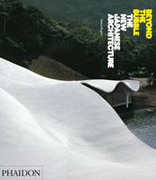
The book looks at two contrasting but equally extraordinary phases in the recent history of Japanese architecture: first, the explosive 'Bubble' era of the1980s and early 1990s, and second, the post-'Bubble' era which leads up to the present day. The early period, also referred to as the 'new golden age of Japanese architecture', saw a spectacular overproduction of unusual buildings and urban complexes in Japan's major cities; while the period that followed, around the mid-1990s, shows work that demonstrated a sense of modesty, restraint and 'earthly' innovation. The Bubble era was pioneered by names such as Arata Isozaki, Tadao Ando, Fumihiko Maki, Kazuo Shinohara, Toyo Ito, Hiroshi Hara and Shin Takamatsu. With the Japanese economy booming, there was huge investmentin fantastical and often very experimental urban building projects. However, by 1993 financial recession had started to gain a firm grip on the country, affecting it on every level. Japan began restructuring its economy and, as a consequence, social, cultural and architectural changes took place on a big scale. Architects throughout Japan started experimenting and building in new ways. Environmental and ecological concerns led to the development of innovative materials and technologies. This backlash against the overdevelopment and spending that took place in earlier years was led by established figures such as ToyoIto, Tadao Ando, Fumihiko Maki, Ryoji Suzuki, as well as emerging architects including Kengo Kuma, Jun Aoki, Shigeru Ban, Kazuyo Sejima and others. The book is divided into two sections: 'The Bubble Years: The Epitome of Japanese Postmodernism'; and 'After the Bubble: New Realities, New Priorities'. In the first section, architectural projects produced during the 1990s are discussed andillustrated in the general text, while in the latter part of the book more recent projects, mainly from the twenty-first century, will be introduced on an individual basis, with plans, drawings and photos, along with detailed projectdescriptions. The book will handle the whole spectrum of cultural detail to explore Japan's extraordinary architectural life.
- ISBN: 978-0-7148-4575-3
- Editorial: Phaidon
- Encuadernacion: Cartoné
- Páginas: 240
- Fecha Publicación: 01/12/2008
- Nº Volúmenes: 1
- Idioma: Inglés
